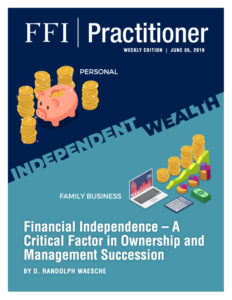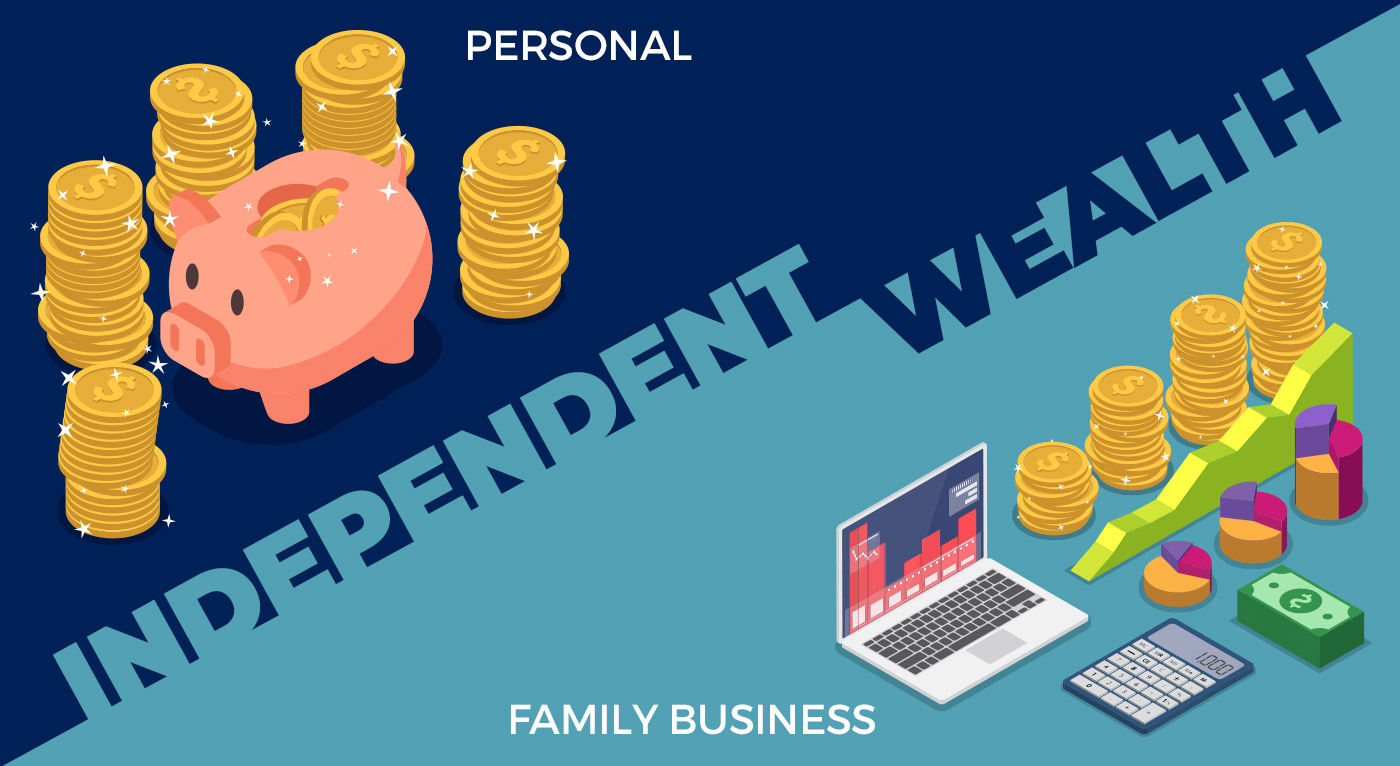
View this edition in our enhanced digital edition format with supporting visual insight and information.
Thank you to this week’s contributor, Randy Waesche, for this thought-provoking examination of the influence that money and financial independence can have in the succession process.
Money seduces. No matter how much family advisors want to avoid the subject, money is seductive. But, as advisors, we cannot avoid the subject. Money, and its ability to render economic independence, is a critical factor in family enterprise succession. Money’s influence, or more appropriately the lack of it, inhibits succession.
Effectively drafted legal documents, sound long-term family planning, corporate governance, and a strong culture embedded with values and purpose are essential ingredients for a family enterprise; but, without the owner’s financial independence from the business, succession is compromised. Financial independence by the transferring generation is critical for a successful transfer to the next generation.
For the family business owner, financial independence can be defined as having enough income to discharge all living expenses for the rest of the owner and his/her spouse’s lives without having to access the financial resources of the business.
However, financial independence, and its association to money, is confusing and not well understood. In many family enterprises, whoever earns the money, and/or whoever controls it, dictates the fate of the family and the enterprise. If all the money and capital is tied to the business, financial independence is not realized. The ability to support one’s lifestyle is still tied to the business. Money is an all-powerful and influential force in ownership and management succession.
An understanding of money, and the liberating financial independence it provides the transferring generation, makes the difference between families that function cooperatively and those that are dysfunctional. In family enterprises, money is not a commodity, but rather a defining element that influences and defines the enterprise. When the assets of the family business are indistinguishable from the transferring generation’s personal assets, the transferor will not and cannot relinquish control or ownership to the next generation without offsetting compensation or continued involvement in management.
Peniaphobia, the fear of poverty, manifests itself in the transferring owner’s procrastination to change. This fear is rarely justified, but it exists. The business’ community prestige, financial benefits, and status become part of an owner’s identity. These intangible benefits are difficult to give up under any circumstances and impossible to relinquish without financial independence from the business.
The separation of family business assets from personal assets takes time, commitment, and potentially, a temporary sacrifice of business growth for personal asset accumulation. It requires professionalism, rigorous investment and divestment criteria, written investment policy statements with defined performance criteria, and cost monitoring. The investment process can be delegated to an unrelated third party, but the investment structure and performance cannot be ignored. One must understand why specific investments are being made in conjunction with the expected risk verses potential return.
Blindly following investment bankers, brokers, or Registered Investment Advisors’ advice historically generates inferior long-term returns compared to investing in low-cost index mutual funds like the Standard & Poor’s 500 Index.* According to some, hedge fund managers rarely generate sustainable returns commensurate with the risk and cost of the investments they underwrite. **
Understanding and mastering practical money skills is a must. As advisors, we must help the family understand that managing money is just as important a life skill as learning table manners or being able to read. Families need to understand how money operates and money’s importance to the family unit. The family—for its own account, or on behalf of the business—should make investments only when its knowledge reaches an experience level where the family can perform effective due diligence on potential investment vehicles.
Factors that aid in separating family enterprise assets from individual assets include the following:
- Retirement Plans: Most countries around the world have some form of individual retirement account. Start early and contribute the maximum to these retirement plans. Make it a corporate and family requirement to contribute.
- Corporate Real Estate: If the enterprise owns real estate, own it personally, not in the corporate entity. Accelerate the mortgage through rental increases so that the mortgage is fully amortized at the owner’s retirement age.
The above two structures, over time, help achieve economic independence, but they are not the only influential factor in achieving economic independence. Adjusting the cost of one’s lifestyle maybe necessary. Far too often, the annual cost of the owner’s lifestyle prohibits economic independence. The goal of retiring from the business is ever present but the reality of sustaining a lifestyle independent of the business post-succession is daunting. As expressed in Matthew 26:41, “The spirit indeed is willing, but the flesh is weak.”
Retired financial advisor Bill Bengen established the four percent theory as the sustainable rate of withdrawal from a portfolio https://www.retailinvestor.org/pdf/Bengen1.pdf. His research concluded that an individual can withdraw, depending upon how the assets are allocated, up to four percent of a portfolio’s value annually to be sustainable; or $40,000 annually per $1million invested. Thus, a business owner withdrawing $500,000 from the business needs approximately $12,500,000 in investable assets outside the business to be economically independent ($500,000/.04 = $12,500,000).
Accumulating $12,500,000 in investment capital outside the business while consuming $500,000 annually is a rare outcome for a growing business, thus the strong dependency on the business to fund a lifestyle.
Succession alternatives to achieving financial independence from the business include these options:
- Selling the business to the next generation: This is a common succession strategy, but the cost of a sale places a heavy burden on the next generation and/or the business from a cash flow perspective and potentially limits the business’ ability to finance growth. Banks avoid businesses with heavy debt, and owners generally don’t subordinate their security interest to the banks.
- Deferred compensation agreements: These compensate owner-employees for under- compensation during periods of growth and provide the selling shareholder the income to subsidize his/her lifestyle. Unfortunately, annual deferred compensation payments hinder business growth and limit distributions to the next generation.
- Gifting ownership interests to the next generation: This approach provides the greatest probability that the business will survive into the next generation, but the owner must be financially independent to make a gift that does not financially burden the next generation or the business. Under U.S. 2019 tax law, the Unified Credit is $11,400,000 per individual. An owner can give $11,400,000 in value, or combine it with a spouse and give $22,400,000 without incurring any gift tax.
- Combined Gift/Sale: If the business is valued at more than the unified credit, a combination of a gift to the maximum amount of the Unified Credit and an installment sale is an effective transfer strategy that provides the selling shareholder income without burdening the business or next generation shareholders with unsustainable costs.
Ownership and management succession in global family businesses is complex, resulting in unacceptably high failure rates. Planning early, being a good steward, educating the next generation, and having good governance with perfectly drafted legal documents in not enough. A family and the family business must prepare financially for succession. As advisors, we should communicate to clients that financial independence is one of the most powerful and pervasive forces within the family business, and its effects and purpose must be understood as an integral factor in family business succession.
References
*Morningstar report – Standard & Poor’s 500 Index yen year average annual return as of April 30, 2019 15.20%. Five-year average return 11.51%.
** Journal of Financial Economics – “Higher risk, lower returns: What hedge fund investors really earn.” LLia D. Dichev and Gwen Yu. January 11, 2011.
About the Contributors

D. Randolph Waesche, FFI Fellow, CFP, is president and CEO of Resource Management, LLC, a Louisiana Registered Investment Advisory firm. He has more than 40 years’ experience as a financial consultant and family business advisor. Randy and his firm are long-time sponsors of the Family Business Review and the FBR Best Reviewer Award. He can be reached at randy@rmiadvisors.com.
About Resource Management, LLC
An award winning advisory firm specializing in wealth management and family enterprise advising for families and businesses worldwide. The firm has been selected by Financial Times as one of the top RIA firms in the country each year for the past six years.

View this edition in our enhanced digital edition format with supporting visual insight and information.





